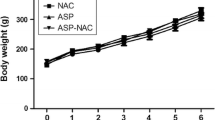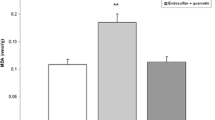Abstract
Acetaminophen, an analgesic and antipyretic drug, rescues neuronal cells from mitochondrial redox impairment and reactive oxygen species (ROS). Excessive administration of acetaminophen above the recommended daily dose range has some negative effects on the brain. We investigated the effects of different doses of acetaminophen on Ca2+-ATPase and the antioxidant redox system in rats. Seventy rats were randomly divided into seven equal groups. The first was used for the control. One dose of 5, 10, 20, 100, 200, and 500 mg/kg acetaminophen was intraperitoneally administered to rats constituting the second, third, fourth, fifth, sixth, and seventh groups, respectively. After 24 h, brain cortical samples were taken and brain microsomal samples were obtained by ultracentrifugation. Brain and microsomal lipid peroxidation (LP) and brain calcium levels in the sixth and seventh groups were increased compared to control. LP levels in the second, third, and forth groups; brain vitamin E levels; brain and microsomal glutathione peroxidase (GSH-Px); and Ca2+-ATPase activity in the sixth and seventh groups were lower than in control, although brain vitamin E concentrations in the second, third, fourth, and fifth groups and microsomal GSH-Px activity in the third and fourth groups were higher than in control. Brain cortical β-carotene and vitamin A concentrations did not differ in the seven groups. In conclusion, 5–100 mg/kg acetaminophen seems to have protective effects on oxidative stress-induced brain toxicity by inhibiting free radicals and supporting the antioxidant redox system.


Similar content being viewed by others
References
Bisaglia M, Venezia V, Piccioli P, Stanzione S, Porcile C, Russo C, Mancini F, Milanese C, Schettini G (2002) Acetaminophen protects hippocampal neurons and PC12 cultures from amyloid beta-peptides induced oxidative stress and reduces NF-kappaB activation. Neurochem Int 41:43–54
Colegrove SL, Albrecht MA, Friel DD (2000) Dissection of mitochondrial Ca2+ uptake and release fluxes in situ after depolarization-evoked [Ca2+] i elevations in sympathetic neurons. J Gen Physiol 115:351–370
Desai ID (1984) Vitamin E analysis methods for animal tissues. Methods Enzymol 105:138–147
Doğru Pekiner B, Daş Evcimen N, Nebioğlu S (2005) Diabetes-induced decrease in rat brain microsomal Ca2+-ATPase activity. Cell Biochem Funct 23:239–243
Duchen MR (2000) Mitochondria and calcium: from cell signalling to cell death. J Physiol 529:57–68
Eren I, Nazıroğlu M, Demirdaş A (2007) Protective effects of lamotrigine, aripirazole and escitalopram on depression-induced oxidative stress in rat brain. Neurochem Res 32:1188–1195
González A, Pariente JA, Salido GM (2007) Ethanol stimulates ROS generation by mitochondria through Ca2+ mobilization and increases GFAP content in rat hippocampal astrocytes. Brain Res 1178:28–37
Gutiérrez-Martín Y, Martín-Romero FJ, Henao F, Gutiérrez-Merino C (2005) Alteration of cytosolic free calcium homeostasis by SIN-1: high sensitivity of L-type Ca2+ channels to extracellular oxidative/nitrosative stress in cerebellar granule cells. J Neurochem 92:973–989
Hadzimichalis NM, Baliga SS, Golfetti R, Jaques KM, Firestein BL, Merrill GF (2007) Acetaminophen-mediated cardioprotection via inhibition of the mitochondrial permeability transition pore-induced apoptotic pathway. Am J Physiol 293:H3348–H3355
Halliwell B (2006) Oxidative stress and neurodegeneration: where are we now? J Neurochem 97:1634–1658
James LP, Mayeux PR, Hinson JA (2003) Acetaminophen-induced hepatotoxicity. Drug Metab Dispos 31:1499–1506
Jaques-Robinson KM, Golfetti R, Baliga SS, Hadzimichalis NM, Merrill GF (2008) Acetaminophen is cardioprotective against H2O2-induced injury in vivo. Exp Biol Med (Maywood) 233:1315–1322
Lawrence RA, Burk RF (1976) Glutathione peroxidase activity in selenium-deficient rat liver. Biochem Biophys Res Commun 71:952–958
Lei XG, Zhu JH, McClung JP, Aregullin M, Roneker CA (2006) Mice deficient in Cu, Zn-superoxide dismutase are resistant to acetaminophen toxicity. Biochem J 399:455–461
Li XD, Xia YLv, He P, Han J, Wu C (2004) Conjugation metabolism of acetaminophen and bilirubin in extrahepatic tissues of rats. Life Sci 74:1307–1315
Lowry OH, Rosebrough NJ, Farr AL, Randall RJ (1951) Protein measurement with the Folin- phenol reagent. J Biol Chem 193:265–275
Lu ZB, Li Q, Ye BP, Bian S, Wang Y, Ruan QP, Wu WT (2004) Protective effects of shark hepatic stimulator substance against acute hepatic injury induced by acetaminophen in mice. Acta Pharmacol Sin 39:17–21
Maharaj H, Maharaj DS, Saravanan KS, Mohanakumar KP, Daya S (2004) Aspirin curtails the acetaminophen-induced rise in brain norepinephrine levels. Metab Brain Dis 19:71–77
Maharaj H, Maharaj DS, Daya S (2006) Acetylsalicylic acid and acetaminophen protect against MPP+-induced mitochondrial damage and superoxide anion generation. Life Sci 78:2438–2443
Nakagawa H, Maeda S, Hikiba Y, Ohmae T, Shibata W, Yanai A, Sakamoto K, Ogura K, Noguchi T, Karin M, Ichijo H, Omata M (2008) Deletion of apoptosis signal-regulating kinase 1 attenuates acetaminophen-induced liver injury by inhibiting c-Jun N-terminal kinase activation. Gastroenterology 135:1311–1321
Nazıroğlu M (2007a) Molecular mechanisms of vitamin E on intracellular signaling pathways in brain. In: Goth L (ed) Reactive oxygen species and diseases. Research Signpost Press, Kerala, India, pp 239–256
Nazıroğlu M (2007b) New molecular mechanisms on the activation of TRPM2 channels by oxidative stress and ADP-ribose. Neurochem Res 32:1990–2001
Nazıroğlu M (2009) Role of selenium on calcium signaling and oxidative stress-induced molecular pathways in epilepsy. Neurochem Res. doi:10.1007/s11064-009-0015-8
Nazıroğlu M, Kutluhan S, Uğuz AC, Çelik Ö, Bal R, Butterworth PJ (2009) Topiramate and vitamin E modulates the electroencephalography records, brain microsomal and blood antioxidant redox system in pentylentetrazol-induced seizure of rats. J Membr Biol 229:131–140
Nencini C, Giorgi G, Micheli L (2007) Protective effect of silymarin on oxidative stress in brain. Phytomedicine 14:129–135
Niggli V, Adunyah ES, Penniston JT, Carafoli E (1981) Purified (Ca2+-Mg2+)-ATPase of the erythrocyte membrane. Reconstitution and effect of calmodulin and phospholipids. J Biol Chem 256:395–401
Olaleye MT, Rocha BT (2008) Acetaminophen-induced liver damage in mice; effects of some medicinal plants on the oxidative defense system. Exp Toxicol Pathol 59:319–327
Özmen I, Nazıroğlu M, Alicı HA, Sahin F, Cengiz M, Eren İ (2007) Spinal morphine administration reduces the fatty acid contents in spinal cord and brain in rabbits due to oxidative stress. Neurochem Res 32:19–25
Patel M (2004) Mitochondrial dysfunction and oxidative stress: cause and consequence of epileptic seizures. Free Radic Biol Med 37:1951–1962
Placer ZA, Cushman L, Johnson BC (1966) Estimation of products of lipid peroxidation (malonyl dialdehyde) in biological fluids. Anal Biochem 16:359–364
Schildknecht S, Daiber A, Ghisla S, Cohen RA, Bachschmid MM (2008) Acetaminophen inhibits prostanoid synthesis by scavenging the PGHS-activator peroxynitrite. FASEB J 22:215–224
Sedlak J, Lindsay RHC (1968) Estimation of total, protein bound and non-protein sulfhydryl groups in tissue with Ellmann’ s reagent. Anal Biochem 25:192–205
Suzuki J, Katoh N (1990) A simple and cheap method for measuring vitamin A in cattle using only a spectrophotometer. Jpn J Vet Sci 52:1282–1284
Tripathy D, Grammas P (2009a) Acetaminophen inhibits neuronal inflammation and protects neurons from oxidative stress. J Neuroinflamm 6:10
Tripathy D, Grammas P (2009b) Acetaminophen protects brain endothelial cells against oxidative stress. Microvasc Res 77:289–296
Van Dyke K, Sacks M, Qazi N (1998) A new screening method to detect water-soluble antioxidants: acetaminophen (Tylenol) and other phenols react as antioxidants and destroy peroxynitrite-based luminol-dependent chemiluminescence. J Biolumin Chemilumin 13:339–348
Whanger PD (2001) Selenium and the brain: a review. Nutr Neurosci 4:81–97
Yatin SM, Varadarajan S, Butterfield DA (2000) Vitamin E prevents Alzheimer’s amyloid beta-peptide (1–42)-induced neuronal protein oxidation and reactive oxygen species production. J Alzheimers Dis 2:123–131
Yee SB, Bourdi M, Masson MJ, Pohl LR (2007) Hepatoprotective role of endogenous interleukin-13 in a murine model of acetaminophen-induced liver disease. Chem Res Toxicol 20:734–744
Zaidi A, Fernandes D, Bean JL, Michaelis ML (2009) Effects of paraquat-induced oxidative stress on the neuronal plasma membrane Ca2+-ATPase. Free Radic Biol Med. doi:10.1016/j.freeradbiomed.2009.08.018
Author information
Authors and Affiliations
Corresponding author
Additional information
Abstract of a study submitted to the 2nd International Biophysics Congress and Biotechnology at GAP, which will be held October 5–9, 2009, Diyarbakır, Turkey.
Rights and permissions
About this article
Cite this article
Nazıroğlu, M., Cihangir Uğuz, A., Koçak, A. et al. Acetaminophen at Different Doses Protects Brain Microsomal Ca2+-ATPase and the Antioxidant Redox System in Rats. J Membrane Biol 231, 57–64 (2009). https://doi.org/10.1007/s00232-009-9203-3
Received:
Accepted:
Published:
Issue Date:
DOI: https://doi.org/10.1007/s00232-009-9203-3




